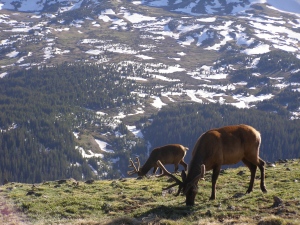 Not long ago I finished A Lady’s Life in the Rocky Mountains by Isabella Bird. The book covers her remarkable travels as an Englishwoman in the nineteenth century American West.
Not long ago I finished A Lady’s Life in the Rocky Mountains by Isabella Bird. The book covers her remarkable travels as an Englishwoman in the nineteenth century American West.
Bird was subject to ill health and traveled, as many did at that time, to different climates to restore her strength. Among other places she also visited Hawaii as well as Canada, Japan and China. In this case Bird was on a trip to reach Estes Park, Colorado.
Her journey begins at Lake Tahoe and she travels east from there into Colorado. Given the strictures of the time she was unusual as an independent woman who traveled alone and un-chaperoned through vast prairies and mountainous regions. With the exception of a few close calls she remained quite safe. After her return she compiled letters written to family into a journal of her travels and published it for sale.
The narrative is full of action and moves quickly, so it is a worthy read if you are interested in doing a little time travel and getting some firsthand experience in the “old west.”
Word pictures
Two things stand out from the book. First, is Bird’s ability to use language to describe her surroundings. The book is un-illustrated, but I was surprised at how little I missed photographs or maps. Her descriptions are precise and show a facility of language usage that is completely lacking these days.
Here are a few samples:
“The stars were intensely bright, and a well-defined auroral arch, throwing off fantastic coruscations, lighted the whole northern sky. Yet I was only in the Foot Hills, and Long’s glorious Peak was not to be seen (p. 229, Comstock Editions, INC., 1987).”
Who uses the word “coruscations” these days? (It means “sparklings and glitterings,” by the way.)
“Long’s Peak, 14,700 feet high, blocks up one end of Estes Park, and dwarfs all the surrounding mountains. … By sunlight or moonlight its splintered grey crest is the one object which, in spite of wapiti and bighorn, skunk and grizzly, unfailingly arrests the eyes. From it come all storms of snow and wind, and the forked lightnings play round its head like a glory. It is one of the noblest of mountains, but in one’s imagination it grows to be much more than a mountain. It becomes invested with a personality (pp.78-79).”
I know that a picture can speak a thousand words, but words like these can speak a thousand pictures!
At your leisure…
Secondly, the descriptions of life at this time in American (and British) history fill a need-to-know of mine. When I sit down in the evening to watch a television show or movie I sometimes ponder at the passivity of my modern habits. It doesn’t take much intellectual stimulation to watch a video (which is sometimes the point after a busy day), but on the other hand, how much of the human brain do we leave inactive for the sake of “entertainment.”
The following quote from the book gives a hint at the kind of end-of-day events common in the early 1870’s:
“After that we all sit in the living room, and I settle down to write to you, or mend my clothes, which are dropping to pieces. Some sit round the table playing at eucre, the strange hunters and prospectors lie on the floor smoking, and rifles are cleaned, bullets cast, fishing flies made, fishing tackle repaired, boots are waterproofed, part-songs are sung, and about half-past eight I cross the crisp grass to my cabin, always expecting to find something in it [based on a previous encounter with a skunk] (pp. 108-109).”
Life was not a piece of cake and leisure time was at a minimum. If you wanted to hear music, you sang it. If you wanted amusement, you played cards. Otherwise you were busy repairing your equipment.
Travel by book – I highly recommend this volume as your personal tour guide into the past!
